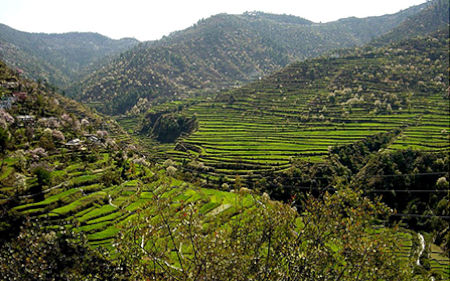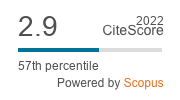Conceptual model development for landscape management in the mountains of the Indian Himalayan region: an approach for sustainable socio-ecological development
DOI:
https://doi.org/10.3097/LO.201018Keywords:
Himalayas, Integrated interdisciplinary modeling, Sustainable development, TradeoffsAbstract
This study aims at presenting a conceptual model for landscape management in the Himalayan region of India, using quantitative/mathematical approach. Keeping in view the requirement, (based on fifteen years empirical field work in the Himalayan region and as well as literature survey) the MODAM (Multiple Objectives Decision Support Tools for Landscape Management) model along with linear programming approach was adopted with a view to presenting additional methodological perspectives on interdisciplinary landscape research. The work has stemmed out from the original research contribution, which tries to integrate interdisciplinary research planning with landscape management related research in the Himalayan region. This biodiversity hotspot has relatively high complexity in terms of sustainable socioeconomic development vis a vis conservation and management of the resources. The concepts and insights presented in this article will provide the basis for a discussion, on decision-making issues among multidisciplinary experts with regard to sustainable socioecological development within complex environments.
References
Balasubramamiam, C., Somasundaram, M. V., & Pundarikanthan, N. V. (1996). LP analysis in a tank irrigation system for near real representation and optimal allocation of area. Irrigation and Drainage Systems, 10(2), 143-158. doi:10.1007/BF01103698
Belovsky, G. E. (1994). How good must models and data be in ecology? Oecologia, 100(4), 475-480. doi:10.1007/BF00317870
Belovsky, G. E. (1990). How important are nutrient constraints in optimal foraging models or are spatial/temporal factors more important? Behavioural Mechanisms of Food Selection, , 255-278.
Bettinger, P. (1999). Distributing GIS capabilities to forestry field offices: Benefits and challenges. Journal of Forestry, 97(6), 22-26.
Bettinger, P., & Boston, K. (2001). A conceptual model for describing decision-making situations in integrated natural resource planning and modeling projects. Environmental Management, 28(1), 1-7. doi:10.1007/s002670010201
Dale, V. H., King, A. W., Mann, L. K., Washington-Allen, R. A., & Mccord, R. A. (1998). Assessing land-use impacts on natural resources. Environmental Management, 22(2), 203-211. doi:10.1007/s002679900097
Deadman, P. J. (1999). Modelling individual behaviour and group performance in an intelligent agent-based simulation of the tragedy of the commons. Journal of Environmental Management, 56(3), 159-172. doi:10.1006/jema.1999.0272
Farrow, A., & Winograd, M. (2001). Land use modelling at the regional scale: An input to rural sustainability indicators for central america. Agriculture, Ecosystems and Environment, 85(1-3), 249-268. doi:10.1016/S0167-8809(01)00192-X
Gemino, A., & Wand, Y. (2004). A framework for empirical evaluation of conceptual modeling techniques. Requirements Engineering, 9(4), 248-260.
Gómez-Sal, A., Belmontes, J. -., & Nicolau, J. -. (2003). Assessing landscape values: A proposal for a multidimensional conceptual model. Ecological Modelling, 168(3), 319-341. doi:10.1016/S0304-3800(03)00144-3
Gonzalez-Perez, C., & Henderson-Sellers, B. (2007). Modelling software development methodologies: A conceptual foundation. Journal of Systems and Software, 80(11), 1778-1796. doi:10.1016/j.jss.2007.02.048
Hazell, P. B. R., & Norton, R. D. (1986).
Herrick, J. E., Bestelmeyer, B. T., Archer, S., Tugel, A. J., & Brown, J. R. (2006). An integrated framework for science-based arid land management. Journal of Arid Environments, 65(2), 319-335. doi:10.1016/j.jaridenv.2005.09.003
Hillman, T., Crase, L., Furze, B., Ananda, J., & Maybery, D. (2005). Multidisciplinary approaches to natural resource management. Hydrobiologia, 552(1), 99-108. doi:10.1007/s10750-005-1508-3
Hobbs, N. T. (1990). Diet selection by generalist herbivores: A test of the linear programming model. Behavioural Mechanisms of Food Selection, , 395-413.
Huggard, D. J. (1994). A linear programming model of herbivore foraging: Imprecise, yet successful? Oecologia, 100(4), 470-474. doi:10.1007/BF00317869
Ives, J. D., & Messerli, B. (1989). The himalayan dilemma: Reconciling development and conservation. The Himalayan Dilemma: Reconciling Development and Conservation,
Jackson, L. J., Trebitz, A. S., & Cottingham, K. L. (2000). An introduction to the practice of ecological modeling. Bioscience, 50(8), 694-706. doi:10.1641/0006-3568(2000)050[0694:AITTPO]2.0.CO;2
Janssen, S., & van Ittersum, M. K. (2007).
Kächele, H., & Dabbert, S. (2002). An economic approach for a better understanding of conflicts between farmers and nature conservationists - an application of the decision support system MODAM to the lower odra valley national park. Agricultural Systems, 74(2), 241-255. doi:10.1016/S0308-521X(01)00087-7
Klevmarken, A. (1983).
Lee, B., Meneghin, B., Turner, M., & Hoekstra, T. (2003).
Leleu, H. (2006). A linear programming framework for free disposal hull technologies and cost functions: Primal and dual models. European Journal of Operational Research, 168(2 SPEC. ISS.), 340-344. doi:10.1016/j.ejor.2004.04.042
Lonergan, S., Gustavson, K., & Carter, B. (2000). The index of human insecurity. AVISO (Ottawa, Ont.), (6), 1-7.
Maikhuri, R. K., Nautiyal, S., Rao, K. S., Chandrasekhar, K., Gavali, R., & Saxena, K. G. (2000). Analysis and resolution of protected area-people conflicts in nanda devi biosphere reserve, india. Environmental Conservation, 27(1), 43-53. doi:10.1017/S0376892900000060
Maikhuri, R. K., Nautiyal, S., Rao, K. S., & Saxena, K. G. (1998). Medicinal plant cultivation and biosphere reserve management: A case study from the nanda devi biosphere reserve, himalaya. Current Science, 74(2), 157-163.
Martínez-Fernández, J., Esteve-Selma, M. A., & Calvo-Sendín, J. F. (2000). Environmental and socioeconomic interactions in the evolution of traditional irrigated lands: A dynamic system model. Human Ecology, 28(2), 279-299. doi:10.1023/A:1007024204961
Moody, D. L. (2005). Theoretical and practical issues in evaluating the quality of conceptual models: Current state and future directions. Data and Knowledge Engineering, 55(3), 243-276. doi:10.1016/j.datak.2004.12.005
Nautiyal, S. (1998).
Nautiyal, S. (2010). Impact of landuse change: Socio-economic and ecological perspective. in: S. nautiyal and B.P. nayak (eds): Ecological economics: An approach towards socioeconomic and environmental sustainability. ISEC & NIE Publication, , 239-247.
Nautiyal, S. (2008). Natural resource management research approach to understand the anthropogenic interactions on ecosystem: Testing the efficiency of conservation policies. Hima Paryavaran, 20, 9-10.
Nautiyal, S. (2009). Research approach to understand the climate change impact at micro level: A case study. in: S. nautiyal and B. P. Nayak (Eds): Climate Change: Data Requirement and Availability, ISEC-CSO, MoSPI, , 150-161.
Nautiyal, S., & Kaechele, H. (2007). Adverse impacts of pasture abandonment in himalayan protected areas: Testing the efficiency of a natural resource management plan (NRMP). Environmental Impact Assessment Review, 27(2), 109-125. doi:10.1016/j.eiar.2006.10.003
Nautiyal, S., & Kaechele, H. (2007). Conserving the himalayan forests: Approaches and implications of different conservation regimes. Biodiversity and Conservation, 16(13), 3737-3754. doi:10.1007/s10531-007-9178-2
Nautiyal, S., & Kaechele, H. (2009). Natural resource management in a protected area of the indian himalayas: A modeling approach for anthropogenic interactions on ecosystem. Environmental Monitoring and Assessment, 153(1-4), 253-271. doi:10.1007/s10661-008-0353-z
Nautiyal, S., Kaechele, H., Rao, K. S., Maikhuri, R. K., & Saxena, K. G. (2007). Energy and economic analysis of traditional versus introduced crops cultivation in the mountains of the indian himalayas: A case study. Energy, 32(12), 2321-2335. doi:10.1016/j.energy.2007.07.011

Downloads
Published
How to Cite
Issue
Section
License
Copyright (c) 2019 Sunil Nautiyal, Kottapalli S. Rado, Harald Kaechele, Peter M. Zander

This work is licensed under a Creative Commons Attribution 4.0 International License.










